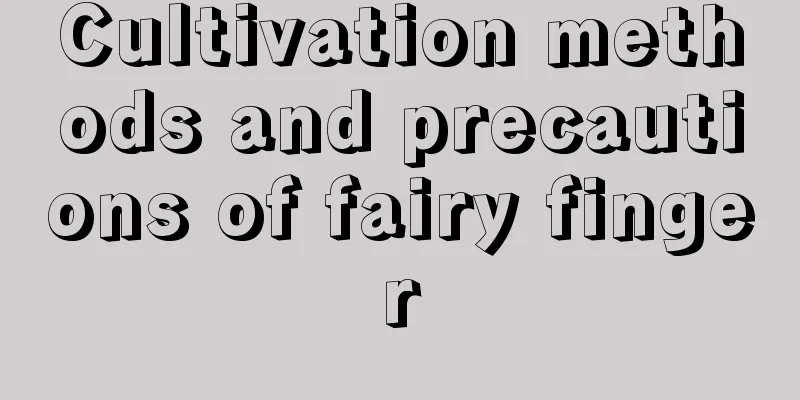Cultivation methods and precautions of fairy finger

Farming methodstemperatureThe suitable growth temperature of fairy finger is between 19-32℃, the suitable temperature in winter is 7-13℃, and it can withstand low temperature of 1-2℃. During the hot summer season, proper shading and ventilation are required. illuminationThe fairy finger is slightly shade-tolerant and is best placed in a semi-shaded environment. It likes sunshine and needs to be given appropriate light throughout the year, otherwise the branches and stems will become thinner, there will be fewer flowers, the flowering period will be short, and the ornamental value will be greatly reduced. Avoid direct sunlight in summer and provide shade. In addition, the fairy finger is a short-light plant and the daily light time needs to be controlled within 10 hours. soilIt grows best in soil rich in organic matter and with good drainage. It grows poorly in clay soil, so 20-30% river sand should be added to the potting soil. FertilizationIt does not like large amounts of fertilizer, and prefers phosphorus and potassium fertilizers, with a thin application of fertilizer once every two weeks. WateringThe fairy finger is relatively drought-resistant. When managing it, the soil in the pot should be kept dry and moist. Avoid watering too much, otherwise it will easily lead to root rot. Water adequately during the growing season. During the low temperature dormancy period in winter, just keep the soil in the pot dry. PrecautionsControl MoistureIt needs to go through a period of dormancy due to freezing in winter, otherwise it will be difficult to bloom. After being frozen, it needs to be kept dry until it is about to bloom, and no watering is required during this period. After entering spring, you still don't need to water it. Wait until the flower buds are the size of soybeans before you start watering it thoroughly. This can promote the formation of more flower buds on the cactus and facilitate flowering. After the cactus blooms and during its dormancy period in high temperatures in summer, it is necessary to control the amount of water and prevent rain to avoid root rot. Repotting and pruningRepotting should be done once every two years, and the substrate can be prepared with materials such as leaf mold, peat soil, and rice husk ash. In spring, pruning work should be carried out in conjunction with repotting, removing overly dense branches and shortening the remaining branches. Spray lime sulfur after pruning to reduce spring pathogen damage. Pest controlPrevention is the key, with special attention paid to the control of scale insects and stem rot. Drugs for general diseases and insect pests can be mixed, and drugs such as carbendazim and thiophanate-methyl can be used alternately. |
<<: What are the varieties of colorful peppers?
>>: The difference between white magnolia and white orchid
Recommend
Cultivation methods and precautions of Golden Phoenix
1. Soil Goldenrod has low requirements for soil a...
How often should rooting water be watered?
Flower cultivation cannot do without rooting liqu...
The reason why roses wither as soon as they sprout
1. What is the reason? 1. Too much water: It with...
Tips for placing dianthus
Dianthus placed on the balcony Depending on the i...
When will the golden marbles bloom and bear fruit?
When does the golden marble bloom? The golden bal...
Daisy flower language, daisy pictures
1. Flower language introduction 1. Hidden love: t...
The main value of snapdragon
The main value of snapdragon: ornamental Snapdrag...
Can Mimosa be exposed to the sun? Can it be exposed to direct sunlight?
Can Mimosa be exposed to the sun? Mimosa can be e...
Cultivation technology of kiwi fruit
Kiwi is a delicious and nutritious fruit. Because...
How to plant purple bamboo
1. Prepare the ground for bed Choose fertile, loo...
What to do if the trunk of the fortune tree is half rotten? How to save the rotten trunk
1. Pruning Once you find that the trunk of the mo...
How to grow hydroponic flowers
1. Maintenance methods 1. Temperature: Depending ...
How to breed Jihong Komatsu
1. Maintenance methods 1. Temperature: A warm env...
Can soaking your feet in mugwort help you lose weight? What are the benefits of soaking your feet in mugwort?
1. Can I lose weight? Soaking your feet in mugwor...
Why are the leaves of jasmine withering?
1. Insufficient light Reason: Jasmine loves sunli...









